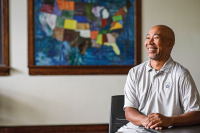Casino a catalyst for re-discovery of Cherokee power
Casino dollars, and lots of them, have brought the Eastern Band of Cherokee Indians newfound clout this past decade, from the legislature in Raleigh to the halls of Congress in Washington, D.C.
“It has put us at the table,” Larry Blythe, the tribe’s vice chief, said in a blunt assessment of the tribe’s political transformation since Harrah’s Cherokee Casino opened in November 1997. “I would say that we’ve always been recognized and listened to as an important tourist destination. But the political influence — we didn’t have the influence we have now.”
With gaming money came the benefits of being able to attract and hire the state and nation’s top lobbyists. Money also brought tribal leaders the ability to wine and dine state and national leaders when needed to try to influence votes and shape perceptions.
Gone are the days when Cherokee could ill afford to even send its leaders to Raleigh, much less to visit leaders in the U.S. House and Senate. Before the casino, Blythe said, the hard work of individual Cherokee leaders to build political bridges was hampered by being money-poor and, perhaps more importantly, by the perception of Cherokee and its people as politically insignificant.
“Lobbyist can open doors, and we can truly now step through them,” Blythe said. “And we can go en masse, and we can go in force.”
Related Items
Bridging Indian and white
Sara Waldroop lives in Franklin, but she keeps a close eye on politics in her home community of Cherokee. She is an enrolled member of the Eastern Band, and the 74-year-old never misses voting in tribal elections. Waldroop was formerly the director of the board of elections in Macon County, and she now serves as chairman of that county’s election board.
You could accurately say that given her professional background, Waldroop’s political perceptions are a bit more honed than many. These days, for the most part, she likes what she sees — a principal chief, Michell Hicks, who has financial acumen (he once served as the tribe’s finance director) re-elected for yet another term, and a tribe that doesn’t shy from taking a leadership role in the region.
SEE ALSO: A rising tide lifts all boats
SEE ALSO: New Cherokee Home Center fills a void
That’s a far cry from the situation Waldroop remembers growing up, when Cherokee families such as her own lived paycheck to paycheck, running credit tabs at one of the two stores in that area. Her father worked for the Great Smoky Mountains National Park, and they lived in Ravensford and later in Smokemont Campground. Her grandfather was white (Major McGee, who grew up in Big Cove, spoke fluent Cherokee and who proved instrumental in reconstructing Mingus Mill), her grandmother, Cherokee. Waldroop, of the Yellowhill community, found herself with pretty much with an equal stake in two worlds, Indian and white.
She went to school in neighboring Bryson City. Waldroop doesn’t particularly remember there being notable differences between the Cherokee children and their white classmates. No overt racism, no particular distinctions made by adults. Then, as now, Cherokee children were not a novelty in Swain County’s school system, or in neighboring Jackson County. Besides, Waldroop said, no one had much money — Indians or whites. And that created a commonality that transcended race. Everyone was of the mountains, and no one had dollars to spare.
“I don’t think we had it any harder than anyone else,” Waldroop said. “So we didn’t think that much about it (any differences).”
Waldroop believes the addition of the casino, overall, has been good for Cherokee.
“It’s another world from what we had back in the 40s and 50s,” she said, adding that Cherokee tribal members actually seem more aware these days of their culture, and take real, visible pride in being Indian. When the casino was being built, some tribal members openly worried that Cherokee would lose its unique cultural identity.
Instead, Waldroop said, “the casino, I think, has really helped.”
Bridging white and Indian
Growing up at about the same time, storyteller and all-around regional personality Gary Carden was experiencing the flipside from Waldroop. A white kid from Jackson County, Carden washed dishes at the bus station in Cherokee for then manager Winona Digh, later Winona Whitetree.
“That was the best deal around, $12 a week,” he noted. “I remember coming into town in the early morning fog and seeing Fess Parker wading across the Oconaluftee with Buddy Ebsen. They were filming ‘Davy Crockett.’ A lot of Cherokees got steady work with the Disney’s film crew and some of them traveled to Mexico for the Alamo scenes because Disney felt that they looked like Mexicans. I later recognized some of my friends in the Mexican army that invaded the Alamo.”
It would be hard to over-emphasize the economic importance of tourism in those days, and “Davy Crockett” and the and the lure of real live American Indians helped draw the crowds to this remote corner of the Smokies. Stereotyping was rampant.
“Every day, I sat on the bridge with these Cherokee kids and our favorite thing to do was to watch the tourists,” Carden said. “We’d never seen them before. They were in Studebakers and Henry J’s. We sat out on the bridge and played this silly game where we tried to see the most exotic license plate — New Jersey, Minnesota. But most were from a 100-mile radius.
“They would sometimes pull up and stop, and of course I was this little white kid sitting there in the middle of all the Cherokee. They consistently thought the Cherokee couldn’t speak English. The drivers would roll the window and they would say ‘You got teepee?’ making a teepee motion with their hands. And to the girls, ‘You got papoose?’ and they would take our pictures. Little by little it caught on, and enterprising Cherokee gave them sheet-metal teepees and some of the girls brought their little brothers tied in a bed sheet.”
What developed was a strange new economy based on tourism and faux American Indian culture that was good each year for six months only.
“When the tourists left it was dead in Cherokee, but it created a tourist-oriented economy,” Carden said. “And of course, they had to pretend to be something they weren’t in order to stimulate that economy, and they did it for so long they forgot who they were. Today they are trying to go back to their authentic Cherokee culture.”
No longer reliant on tourists
David Redman helped develop that critical Cherokee tourist trade. A white man, he worked in Cherokee travel and tourism for years, starting in 1988. Like Carden, he saw the limitations of a local economy totally dependent on tourism.
“Unemployment was high in the region for decades, with Swain County reaching the 30-percent level,” Redman said. “It was even higher on the reservation. Prior to the casino, the tribe was probably the strongest tourism destination west of Asheville. However, the tourism season lasted between five and six months (May through October) with employees being laid off until the beginning of the next season.”
Pre-casino, the Cherokee experienced overt discrimination in the region and beyond, Redman said.
“Employees in the tribal program I managed would often complain that area businesses would not accept personal checks and that they were treated differently than non-Indian customers,” he said. “I would take my staff to a Christmas breakfast, sometimes to Pigeon Forge, other times to the Dillard House or Grove Park Inn. Customers’ eyes were on us, and there was a definitely feeling of coolness.”
That said, being white in Cherokee then wasn’t always easy, either.
“How was a white man working for an Indian tribe being accepted?” Redman said. “First, with a huge amount of distrust — a shipload of distrust. Trust between the white and Indian isn’t immediate and mutual. I felt that I had the trust of some Indian co-workers only after five years or more.”
The casino has changed that. Racism certainly still exists here as it does everywhere, and stereotypes of Indian culture live on, too. But the casino, a vast and hungry employer of the region, has helped further mix white and Cherokee. Both work in the managerial ranks, and in a large corporation such as Harrah’s, hard work is the way to climb the corporate ladder.
Cherokee scholar John Finger, a retired professor from the University of Tennessee at Knoxville and the author of several books and academic writings on contemporary Cherokee culture, said he started paying attention to the tribe in the mid-1970s. The changes, Finger said, have been profound.
“I’ve seen the tribe become more economically prosperous, the end result of both the tourist and gaming industries. They seem much more in tune with modern American business and life.”
Like Waldroop, Finger believes the casino has actually strengthened and deepened the Cherokees’ ties to their culture, “making them more aware of their status as Indians, particularly Cherokee Indians.”
And, even as tribe members’ cultural awareness has awakened, the Eastern Band of Cherokee Indians has emerged as a potent political and economic force for all of WNC.









